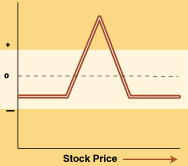Q&A
Explore Your Options
| Got a question about options? Tom Gentile is the chief options strategist at Optionetics (www.optionetics.com), an education and publishing firm dedicated to teaching investors how to minimize their risk while maximizing profits using options. To submit a question, post it on the STOCKS & COMMODITIES website Message-Boards. Answers will be posted there, and selected questions will appear in future issues of S&C. | 
Tom Gentile of Optionetics |
BUTTERFLY SPREADS
Would you be so kind to explain what exactly a butterfly spread is? Thanks - Simon
A butterfly spread is a sideways market strategy using all calls or puts, and is designed to profit from a stock trading in a specific range. They are often cheap to place, offer high rewards, and can be profitable within a few days to a few weeks; so they are ideal for shorter-term swing traders. The construction of the spread generally involves selling (shorting) two contracts in the middle of a stock range (the body) and buying two contracts (the wings) on either side of the short position, one with a higher strike than the short contracts and one with a lower strike. (See Figure 1 for a risk curve.) Your maximum profit on the trade is the difference between the short and long strikes, minus the net debit. Your maximum risk is the total debit minus the credit received for the shorts. The breakevens are calculated by adding the net debit to the lowest strike to get the lower breakeven and subtracting it from the highest strike for the upper breakeven.

FIGURE 1: RISK CURVE FOR BUTTERFLY SPREAD
Identifying support and resistance levels is one of the key components in setting up a traditional butterfly spread. Using basic technical analysis, you should be able to easily identify the support and resistance levels of the stock or underlying and place your long positions at each end of the range. It is not a hard-and-fast rule that the body be shorted in the middle of the range, but it is a good start when analyzing your risk/reward. Let's look at an example:
Suppose that on February 5, stock XYZ has been trading in a three-month range between 40 and 50. The stock currently sits at 45. Since you feel that the stock will continue to trade within this range over the next few weeks, you would like to make some money while it meanders back and forth. Let's construct a trade using the following strikes and prices:
February 40 put = 0.50
February 45 put = 2.50
February 50 put = 6.00
In this example, the total debit of the long positions is 6.50 and the credit received is 5. Therefore, the risk on the trade is the net difference between the two, or 1.50 ($150 per spread). Your maximum profit is 3.50, or $350 per spread. As long as the stock trades between 41.50 and 48.50, you're profitable; your maximum profit is right at 45. It's as simple as that.
Generally, these spreads are very low-risk when done correctly and offer very high rewards. If the implied volatilities of the options happen to be a little higher when placing this trade, it could be an even greater benefit to you. As the volatility comes down, you could profit faster as the time premium in the short contracts dissipates.
SUPERIOR LEVERAGE
Since most of the books out there say that simply buying calls and puts is a losing strategy for most who try it, are there spreads that offer superior leverage or risk management in intraday time frames? Thanks - Craig
Unless you are a market maker, retail traders are very limited in their ability to profit from intraday spread trading due to slippage (the difference between the cost and what you end up paying) and commissions. That's not to say it can't be done; however, in most cases, since profiting on, say, a bull or bear spread requires at least a few points of movement in the underlying, it's generally not a good idea to daytrade these types of strategies. These days, stocks just don't have the same wide range of movement that we saw a couple of years ago, when it may have been more appropriate to trade in this manner.
That said, it's important to know that depending on your risk tolerance, you can still daytrade some options with relative safety without the use of spreads. And although it's not something I typically promote for most traders, there are some cases where trading profits can be made quite frequently using very short-term time frames. During periods of low volatility, for example, many of the indexes, such as the Standard & Poor's 100 and 500 indexes, offer some of the highest liquidity and cheapest prices (relatively speaking) in the options market - particularly in the days prior to expiration, when there is very little time premium left.
As with any type of strategy, it is only as good as the risk management of the trader using it. This is why many people lose at investing, whether they are daytraders or long-term buy-and-holders. If you have a method in mind to implement, be sure to test it on paper for a while to get a sense of how well it really works. Be honest with your tests and yourself; you should only begin to put real money into any strategy after you have seen positive results for a series of similar trades with identical setups. If you're trading options for the first time, it's important to know that it's usually when novice traders don't take the time to truly understand the implications of volatility and time decay that they lose. Remember, options don't lose money, people do!
Originally published in the April 2003 issue of Technical Analysis of STOCKS & COMMODITIES magazine. All rights reserved. © Copyright 2003, Technical Analysis, Inc.
Return to April 2003 Contents